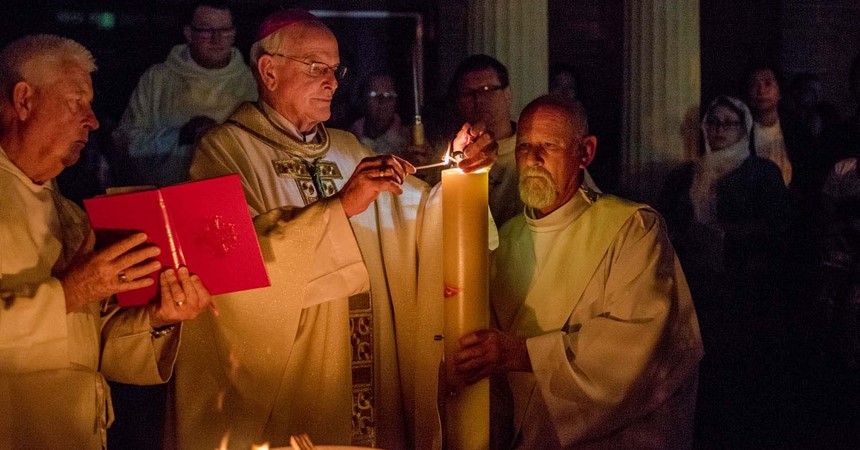If you are not familiar with the notion of mystagogy, and how it works, the following reflection might help.
Noticing what strikes me in the liturgy is the starting point of mystagogy. I offer the following as a simple example.
I got stuck on the fifth Sunday of Lent when we heard the story of the woman caught committing adultery and the leaders who wanted to condemn her to death by stoning. In the first reading that Sunday, from the prophet Isaiah, we heard the Lord say, ‘See, I am doing a new deed, even now it comes to light; can you not see it?’ Then in the Gospel we see God’s new deed when Jesus says to the woman, ‘Neither do I condemn you, go away and sin no more.’ The old deed is condemnation. The new deed is forgiveness. The old deed ends life. The new deed renews life and offers freedom. This is what stayed with me and became my lens for Holy Week.
The next step in mystagogy is to seek to deepen my understanding of this experience. I need to mine it for its meaning for life now. What is God saying to me/us? What is God asking of me/us?
As I ponder this new deed and what it means for me, the liturgical year continues to unfold, dragging me along whether I am ready or not. Finally, my journey through Holy Week brings me to the empty tomb, to Jesus raised to new life as God’s word becomes the final word overpowering condemnation and death. I see the new deed. I hear the proclamation of the new deed. I celebrate the new deed.
But to see, hear and celebrate is not enough. God asks me to participate in the new deed, to live it myself and for the community to live it together. This is difficult and this is why Easter Mystagogy is so important.
Throughout the Easter Season, grounded in the Sunday readings and liturgy, mystagogy, both within and beyond the liturgy, helps me deepen my understanding of the meaning and implications of the great Easter mystery. We who have been enlightened by Christ are sent from the liturgy to spread that light throughout our part of the world.
It is good when liturgy is celebrated well. It is good when it gives voice to the faith of the people as happened at the Chrism Mass last week. Liturgy like that is truly renewing and energising. That said, the true measure of liturgy is how the community lives during the week. Mystagogy empowers liturgy to achieve its end – that we live as the Body of Christ every day, offering ourselves to be broken open and poured out for the life of the world.
To return to my lens, the Gospel I started with, ‘Neither do I condemn you. Go away and sin no more.’ Forgiveness! Freedom! New life! Let us imagine Jesus saying to us, ‘See I am doing a new deed… and I’m doing it now in and through you!’
Enjoy the Easter party. Mystagogy grounded in carefully prepared liturgies and homilies that seek to reveal what is ‘hidden in plain sight’ in the Sunday liturgy will help keep you fit to last the 50 days of Easter partying and to participate in God’s new deed in liturgy and life, week in and week out.
The following questions are typical mystagogical questions.
· Where did you encounter Christ in the liturgy on Sunday? What did you notice? What did you hear, see, feel?
· What does this encounter mean for you?
· What else in our Tradition might help you better understand this meaning?
· How is this encounter shaping your relationship with God?
· How will you live differently because of this encounter? How is Christ changing you?
And another important point, just like liturgy, mystagogy is essentially a communal activity.
Enjoy being a mystagogue!

